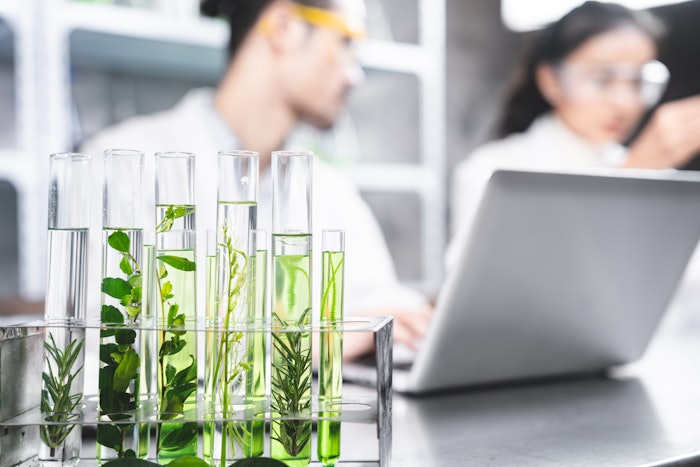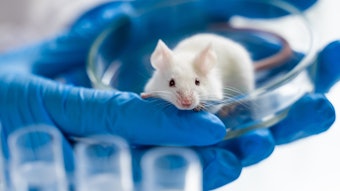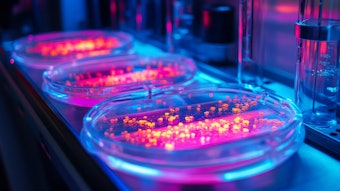
Abstract: Murraya koenigii extracts derived via various techniques were compared. One developed through chem- and bio-guidance paired with a natural deep eutectic technology uncovered lesser-known efficacies, leading to a natural active to boost elastin synthesis.
Various parameters must be taken into consideration during the design process of a new plant-derived active. Aside from the plant's origin, phytochemists must identify the bioactive molecules of interest and choose the solvent that will best extract them. Literature reviews provide first cues, but what about the molecules and efficacies that were not yet identified? Can a plant be rediscovered, and new benefits revealed?
To find out, Murraya koenigii was used as a plant model to assess what the analysis of phytochemical composition (chemoguidance) and biological efficacy (bioguidance) of different extracts could bring to the development process of an active ingredient. Assessments including phytoconstituent extraction, elastic fiber formation, elastin synthesis and clinical efficacy are described here.
An Ayurvedic Aromatic Treasure
Murraya koenigii is a small shrub commonly known as Kaloupile in French, curry leaf in English or Kadi Patta in India. It originates from northern Thailand and India but is now widely cultivated in Southeast Asia and the Indian Ocean. As its English name suggests, the leaves have a strong, typical odor and are often used in culinary applications such as soups, curries or chutneys – not to be confused with the spice mixture curry.
The plant is also reputed for other traditional applications. Ayurveda, the Indian traditional medicine system, uses the leaves, bark and roots for their action on metabolism: anti-inflammation, enhancement of blood circulation, digestion and diabetes prevention. More generally, the literature describes the therapeutic benefits of the plant, such as antioxidant, antimicrobial and healing properties.1-3 These biological activities are associated with its rich molecular composition thoroughly described in scientific literature.4-7
A Well-described Phytochemical Composition
Murraya koenigii's phytochemistry comprises a variety of structurally diverse compounds, including alkaloids, phenolic compounds (flavonoids, phenolic acids, tannins), some terpenoids (saponins, carotenoids) and essential oils. Mineral elements, sugars and amino acids are also present to a lesser extent.
Most of the biological properties described have been attributed to alkaloids,1, 2 particularly in the leaves and sometimes to polyphenols. These molecular families therefore a good starting point from which to investigate the most efficient extraction solvent.
Finding the Right Solvent: Exploring NADES and Natural LTTM
Plant chemists have a wide panel of solvents to explore. Their challenge lies in finding the optimal solution to answer industrial constraints and reach previously defined biological targets. To achieve such, some critical parameters must be considered. A good solvent creates a liquid, stable extract with the lightest color and odor possible, but featuring the highest bioactive molecule content. Additional criteria in the solvent selection process include naturality, safety and eco-design.
Solvent libraries include options that are well-known – such as water, bio-based glycols, bio-ethanol and vegetable oils – and newer ones. Among the latter is a natural deep eutectic solvent (NADES)a technology, which takes inspiration from how nature solubilizes metabolites within plant cells. Through eutectic combinations of sugars and nitrogen compounds, these green solvents emulate the natural processes that occur in plants.
NADES technology can derive active compositions that are unattainable using conventional solvents, as will be shown. These solvents are natural, non-toxic and operate efficiently at lower temperatures.
NADES is a type of natural Low Transition Temperature Mixture (NaLTTM), a large family of solvents characterized by a combination of natural substances in a specific ratio and linked together with intermolecular hydrogen interactions, forming a tight system with regular molecular proximity. This creates a supramolecular structure enabling a glass transition typical of polymers, corresponding to a change of state from rigid to elastic form at a low temperature.
LTTMs are a unique thermal event wherein the solvent evolves from a fixed molecular state like ice to a more mobile one like liquid water. While NADES technologies belong to the NaLTTM family (see depiction in Figure 1), they have an even tighter organization linked to the presence of extensive intermolecular interactions visible through NMR analysis. The present work screened these solvents in comparison with traditional solvents in the case of Murraya koenigii.
 Figure 1. Extraction properties comparison, NaLTTM vs NADES
Figure 1. Extraction properties comparison, NaLTTM vs NADES
Solvent Performance: Phytostituent Extraction Comparison
Murraya koenigii leafy stem extracts were obtained using a variety of solvents. These were screened to compare solvent performance based on the presence of alkaloids and polyphenols (flavonoids and phenolic acids) in the extracts. Conventional (ethanol, propanediol and water) as well as newer solvents (LTTM and NADES) were evaluated.
Some solvents were more selective toward alkaloids and others toward phenolic acids. Hence, the obtained extracts presented a wide panel of molecular compositions (see Figure 2). For example, a NaLTTM was the most efficient solvent for phenolic acids, whereas a hydroethanolic extract solubilized in propanediol was the most efficient solvent for alkaloids and flavonoids.
 Figure 2. Solvent extraction performance of phenolic acids, flavonoids and alkaloids from M. kaenigii leafy stem
Figure 2. Solvent extraction performance of phenolic acids, flavonoids and alkaloids from M. kaenigii leafy stem
Protein Expression vs. Phytostituent Content
Proteomics assessments were also made in normal human fibroblasts to observe the effects of select extracts on protein expression – particularly proteins related to dermal extracellular matrix structure, formation and maintenance. Four extracts with different phytochemical profiles were evaluated: a NaLTTM; a hydroethanolic extract solubilized in propanediol; an ethanol and water fraction of alkaloids without polyphenols; and an ethanol and water fraction of polyphenols without alkaloids.
Elastic fiber formation: The NaLTTM extract based on betaine, water and propanediol in a molar ratio of 1:5:1 interestingly targeted proteins involved in the formation of elastic fibers. This observation was notable considering the literature attributes the plant's efficacy to alkaloids, whereas the NaLTTM extract was rich in phenolic acids and presented only a low concentration of alkaloids.
 Figure 3. Solvent extraction performance of AHA (a), phenolic acids and flavonoids (b) from M. koenigii leafy stem: NaLTTM vs traditional solvents
Figure 3. Solvent extraction performance of AHA (a), phenolic acids and flavonoids (b) from M. koenigii leafy stem: NaLTTM vs traditional solvents
A second study confirmed these results, showing the NaLTTM solvent extracted higher levels of phenolic acids than conventional hydro-ethanolic and hydroglycolic extracts. An investigation of the AHA levels in extracts led to similar a conclusion (see Figure 3).
Elastin synthesis: The second biological efficacy test went a step beyond by directly focusing on elastin synthesis in normal human fibroblasts (see Figure 4). The rich phytochemical imprint of the NaLTTM extract yielded a higher biological response than the traditional extracts.
 Figure 4. Synthesis of deposited elastin by normal human fibroblasts treated with 0.1% M. koenigii leafy stem extract: NaLTTM vs traditional solvents (EtOH/W 70:30 and PDo/W 70:30)
Figure 4. Synthesis of deposited elastin by normal human fibroblasts treated with 0.1% M. koenigii leafy stem extract: NaLTTM vs traditional solvents (EtOH/W 70:30 and PDo/W 70:30)
These results supported the development of an anti-skin sagging ingredientb, whose characterization identified the presence of 50 molecules from five different families (see Figure 5), six of which were phenolic acids; notably ~7% chlorogenic acid. Other polyphenols were also present, such as flavonoids (mainly isoquercitin).
 Figure 5. Estimated phytochemical composition of the anti-skin sagging ingredientb (g/100 g of estimated dry plant extract)
Figure 5. Estimated phytochemical composition of the anti-skin sagging ingredientb (g/100 g of estimated dry plant extract)
What’s more, the ingredient was shown to promote the synthesis of key proteins in the assembly, maintenance and protection of qualitative and functional elastic fibers (see Figure 6) – an activity demonstrated through various in vitro models of increasing complexity. For example, the density of elastic fibers in spheroid models treated with 0.1% active showed a 125% increase, compared with the untreated control; measurements were taken by Second Harmonic Generation Microscopy (SHGM).
 Figure 6. Density of elastic fibers in spheroid models, measured by SHGM
Figure 6. Density of elastic fibers in spheroid models, measured by SHGM
Clinical Efficacy
Finally, the efficacy of the anti-sagging active at 1% was confirmed in a clinical trial on two application areas (face and forearms). The ingredient significantly reinforced skin elasticity (+12%, per cutometry readings) compared with a placebo formula.
In addition, a novel test was designed to demonstrate the effects of the ingredient on gravity-induced aging signs of the lower face. Here, the active decreased deep wrinkles by 49% and redefined facial contours (see Figure 7).
 Figure 7. Nasogenian folds before (left) and after (right) treatment with 1% anti-skin sagging active emulsion
Figure 7. Nasogenian folds before (left) and after (right) treatment with 1% anti-skin sagging active emulsion
Eco-conscious Extraction
As stated earlier, plant chemists are challenged to find solvents that reach previously defined biological targets while also answering industrial constraints – and naturality and sustainability are critical industrial requirements. NaLTTM solvents and NADES present sustainable characteristics, supporting the development of COSMOS-validated, 100% natural origin ingredients (ISO 16128) such as the NaLTTM-based active described hereb.
What’s more, the betaine and propanediol in the anti-sagging activeb naturally preserve it against degradation, bypassing the need for a preservative. Finally, NaLTTM solvents enable the extraction of the plant's precious phytoconstituent content at low temperatures, preserving thermosensitive molecules and limiting energy consumption.
Conclusion
The present work with Murraya koenigii leafy stem extracts demonstrates how the analyses of phytochemical composition (chemoguidance) and biological efficacy (bioguidance) led to the development of an active cosmetic ingredient. Phytochemists and biologists cooperated to perform large and flexible screening campaigns, enabling the selection of the most appropriate solvent to ensure optimal phytoconstituent extraction and, in turn, to target the desired biological effects (elastin fiber synthesis).
The combined approach therefore revealed new properties of Murraya koenigii thanks to the extraction of active molecules that are lesser known in the literature, lending the plant’s uniqueness to a novel cosmetic ingredient. So it appears the answer is yes, a plant can be rediscovered and new benefits revealed for cosmetic applications.
Footnotes
a The NaDES solvent technology is patented by Gattefossé.
b EleVastin (INCI: Betaine (and) Water (Aqua) (and) Propanediol (and) Murraya Koenigii Stem Extract) is a product of Gattefossé.
References
1. Ramsewak, R.S., et al. (1999). Biologically active carbazole alkaloids from Murra ya koenigii. J Agricultural and Food Chem, 2(47) pp 444-447.
2. Nagappan, T., et al. (2012). Efficacy of carbazole alkaloids, essential oil and extract of Murraya koenigii in enhancing subcutaneous wound healing in rats. Molecules, 12(17) pp 14449-14463.
3. Kamat, N., Pearline, D. and Thiagarajan, P. (2015). Murraya koenigii (L.) (curry leaf): A traditional Indian plant. Res J of Pharma Bio and Chem Sci, 5(6) pp 691-697.
4. Suman Kumar, S., et al. (2018). Phytochemical portfolio and anticancer activity of Murraya koenigii and its primary active component, mahanine. Pharmacol Res, 129 pp 227-236.
5. Waghmare, A.N., Tembhurne, S.V. and Sakarkar, D.M. (2015). Phytochemical analysis and in vitro antioxidant properties of Murraya koenigii (L.) fruits. Amer J Phytomed and Clin Therapeutics 5(3).
6. Salomi, M.V. and Manimekalai, R. (2016) Phytochemical analysis and antimicrobial activity of four different extracts from the leaves of Murraya koenigii. Inter J Current Microbio and Appl Sci, 7(5) pp 875-882.
7. Tahia, F., et al. (2015). Alkaloids, coumarin and cinnamic acid derivative from Murraya koenigii (Linn.) Spreng. Daaka University J Pharma Sci, 1(14) pp 29-33.





!['We believe [Byome Derma] will redefine how products are tested, recommended and marketed, moving the industry away from intuition or influence, toward evidence-based personalization.' Pictured: Byome Labs Team](https://img.cosmeticsandtoiletries.com/mindful/allured/workspaces/default/uploads/2025/08/byome-labs-group-photo.AKivj2669s.jpg?auto=format%2Ccompress&crop=focalpoint&fit=crop&fp-x=0.49&fp-y=0.5&fp-z=1&h=191&q=70&w=340)




